Finally, Manchester City showed their capability to beat the best teams in Europe, even though they were playing away from home. At the Santiago Bernabéu, despite Isco scoring first at the hour mark, Real Madrid lost the game as they conceded two goals in the last 30 minutes. Gabriel Jesus’ and Kevin De Bruyne’s goals helped Manchester City to come from behind, while to make things worse for Madrid, Sergio Ramos picked up a red card and will now be suspended for the next leg. City thus have a good start to their Champions League knockout stage.
In this tactical analysis, we will show you how Pep Guardiola’s men beat Real Madrid. It is an analysis that shows you the tactics of both managers.
Lineups
Zinédine Zidane’s team played in a 4-3-3 formation. Ferland Mendy returned to the lineup after being rested for a couple of La Liga games. The midfield trio was formed by Casemiro, Federico Valverde and Luka Modrić; Gareth Bale and Toni Kroos were left on the bench, while Vinícius Júnior started as the left-winger.
City played in a 4-4-1-1. Aymeric Laporte started the game and partnered with Nicolás Otamendi; Rodrigo Hernández and İlkay Gündoğan played as the pivots. It was slightly unusual that Bernardo Silva started as the striker while Jesus was the left-winger.
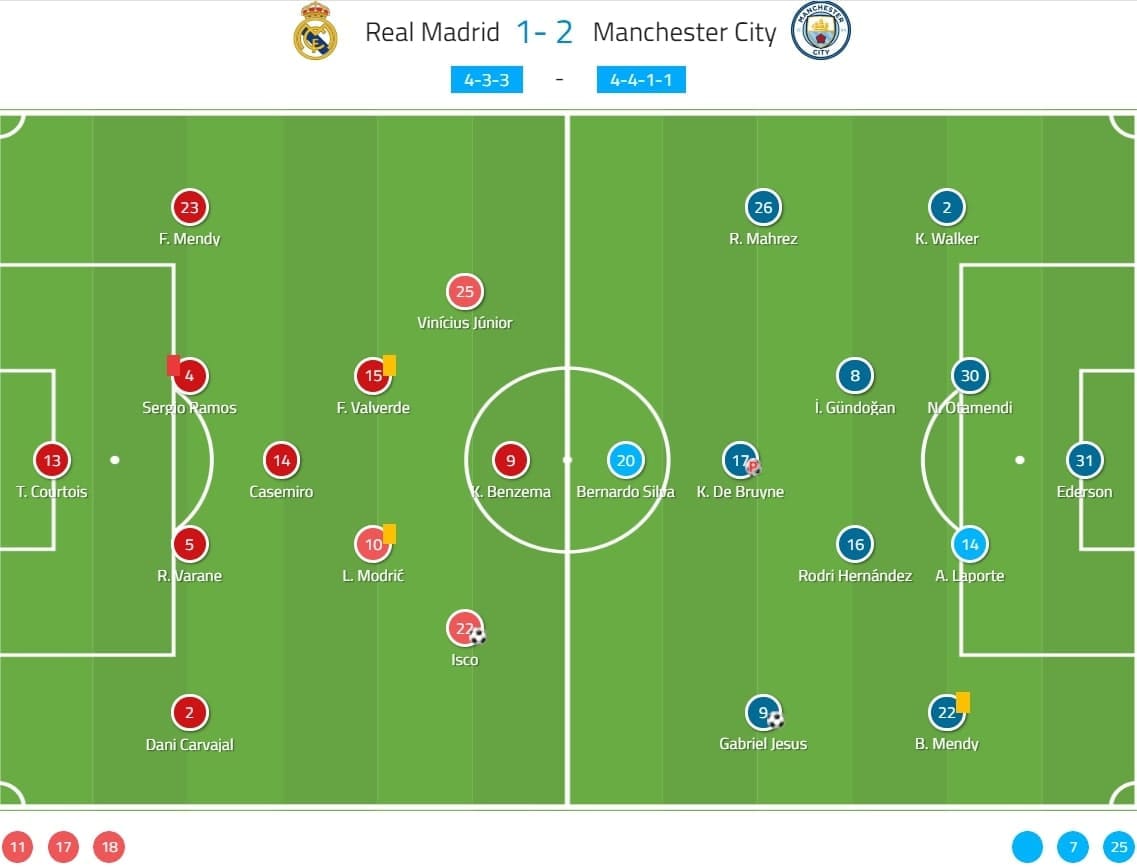
Madrid’s build-up
Zidane’s team did not insist on playing out from the back, but they liked to keep the ball in the first phase of the attack. The general structure of the team gave Los Blancos the stability in the first phase of the attack before City overcame the deficit. Madrid had 562 passes (89%) and 49% of possession, which was very close to City’s 579 (90%) and 51% of possession.
When moving the ball at the back, Madrid successfully outnumbered the defending players, as well as maintaining the width on both flanks. These are all shown in the below image. For the centre-backs, they split wide and allowed Casemiro to sit between them. These three players enjoyed a 3-v-2 numerical advantage against the pressing front two of City. If we included Thibaut Courtois, in fact, they formed a quadrilateral to move the ball, which helped divide them into two passing triangles as well.
On the flanks, the full-backs, F. Mendy and Daniel Carvajal provided the width. Since the central players pinned De Bruyne and B. Silva, both full-backs were enjoying 1-v-1 situations out wide. Isco, Valverde and Modrić overloaded the double-pivot of City; they took turns to drop and provide additional numbers in the build-up. At most, Madrid could have eight outfield players involved in the build-up phase, which created an absolute numerical advantage against City’s pressing players (mainly six to seven players).
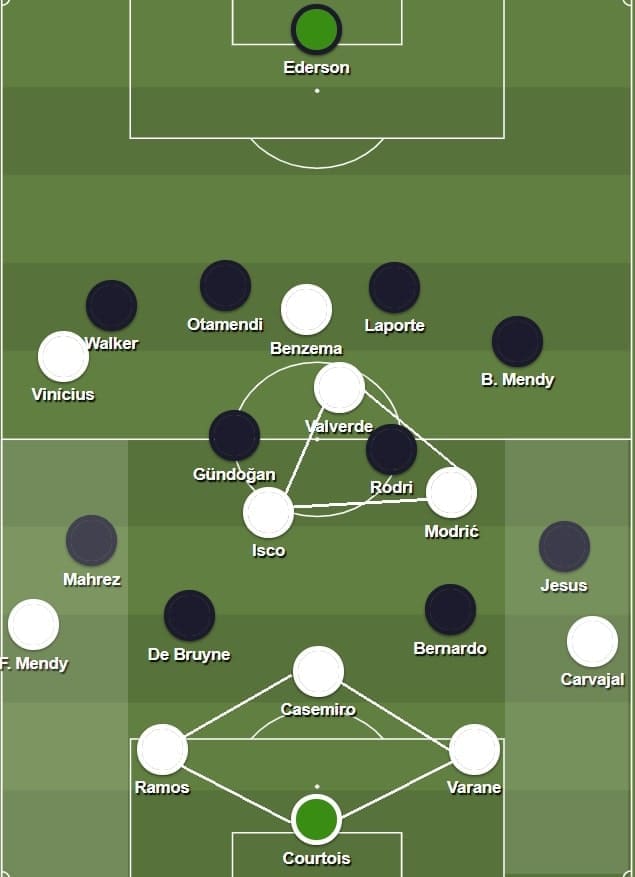
Below are some game examples. First, we show you the passing triangle at the centre. In this scene, Madrid enjoyed a 3-v-2 numerical superiority at the centre. As De Bruyne positioned himself near to Casemiro and B. Silva was on Raphaël Varane, Ramos became the free player to progress the attack without pressure.
For the full-backs, their wide positioning stretched and increased the horizontal gaps between the City players, allowing some wider passing lanes for the out ball.
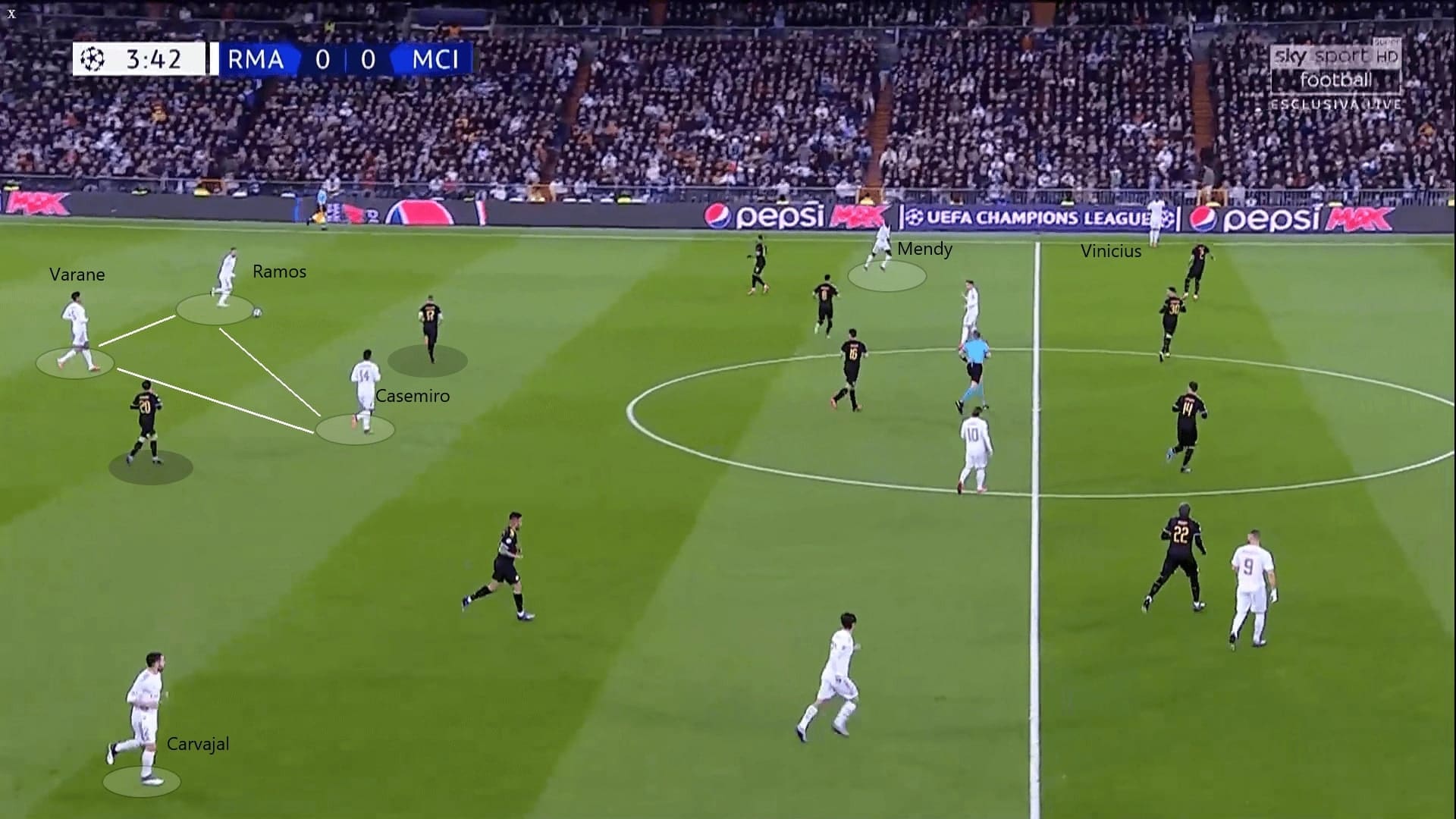
When we divide the pitch roughly to distinguish the wide areas and central region, you can see that City were outnumbered centrally. In this image, the passing triangle still existed. This time, the advanced midfielders dropped to provide outlets for the forward pass. Madrid had a 5-v-4 advantage at the centre.
Through the cleverness of Modrić and Isco, they overloaded Rodri. As the Croatian pinned Rodri, Isco became the free player to receive Varane’s pass. Benjamin Mendy was unsure on whether to track Isco or not; if the Frenchman did, he was far away from his original position. In case the dropping players could not turn, they returned the ball to the ‘third man’ who was facing the opposition goal (he had a wider angle to pick a better option, if any), then circulated the ball again.
Again, the wide positioning of the full-backs was vital, as both F. Mendy and Carvajal forced Jesus and Mahrez to stay wider. This opened a wider passing lane for Varane’s vertical pass.
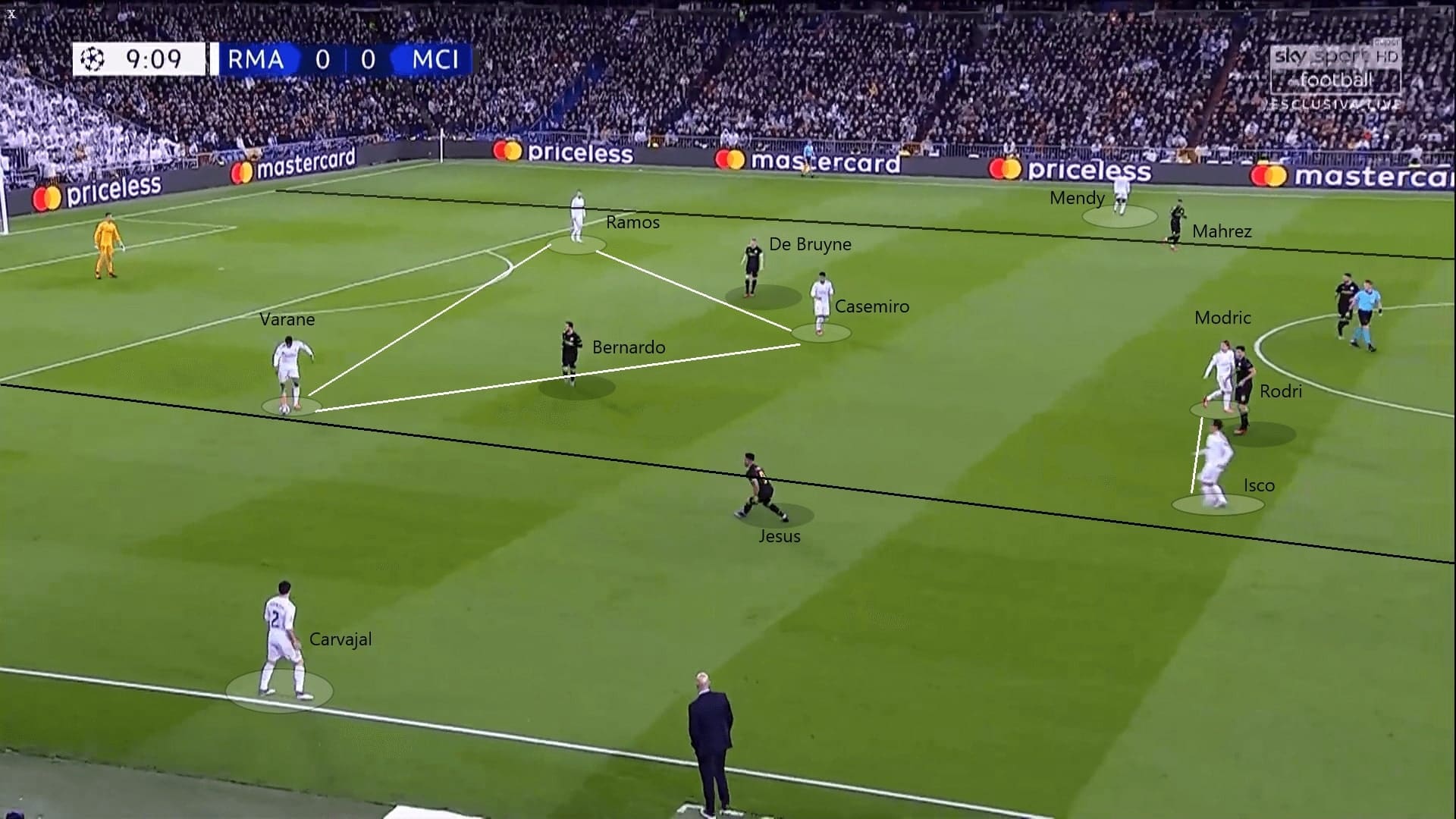
As Guardiola said, City suffered in the first 15 minutes. In that period, the PPDA of the Citizens was 34.3 and Madrid controlled 70% of possession. Los Blancos were confident to move the ball in their own half, this was partly the reason why City were very passive. Apart from the tactical approach as mentioned, in this image, we show you how confident were they.
You can see City had committed numbers on the ball side and they were pressing. However, even under pressure, Ramos still identified his options on the pitch. Varane swapped his position with Carvajal, and he was calm enough to control Ramos’ over-ground pass as well. In that instant, Madrid broke City’s press and shifted the attacking focus to B. Silva’s weak side.
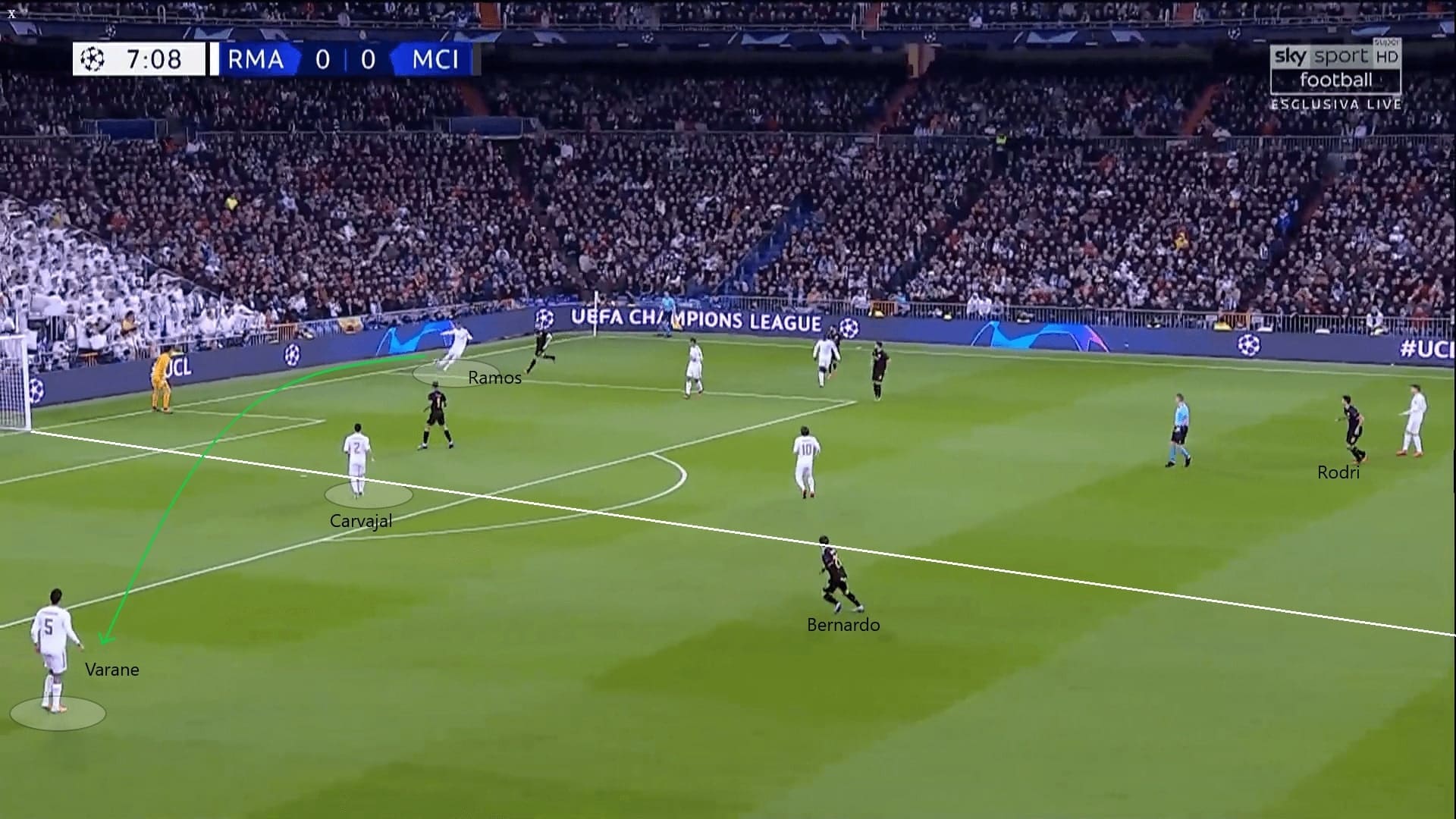
Madrid’s attacking style of play
In this section, we explain how Madrid attacked after the first phase. The main man in their attack was F. Mendy. First, we want to show you a rare case in which Madrid penetrated through City’s press in a positional play. This should be credited to Modrić’s ability. The Croatian drifted to the centre, opened a wider angle for a pass to F. Mendy; also, he fooled De Bruyne into thinking that he was returning the ball to Ramos with his body feint. F. Mendy received the ball behind the press and progressed the attack.
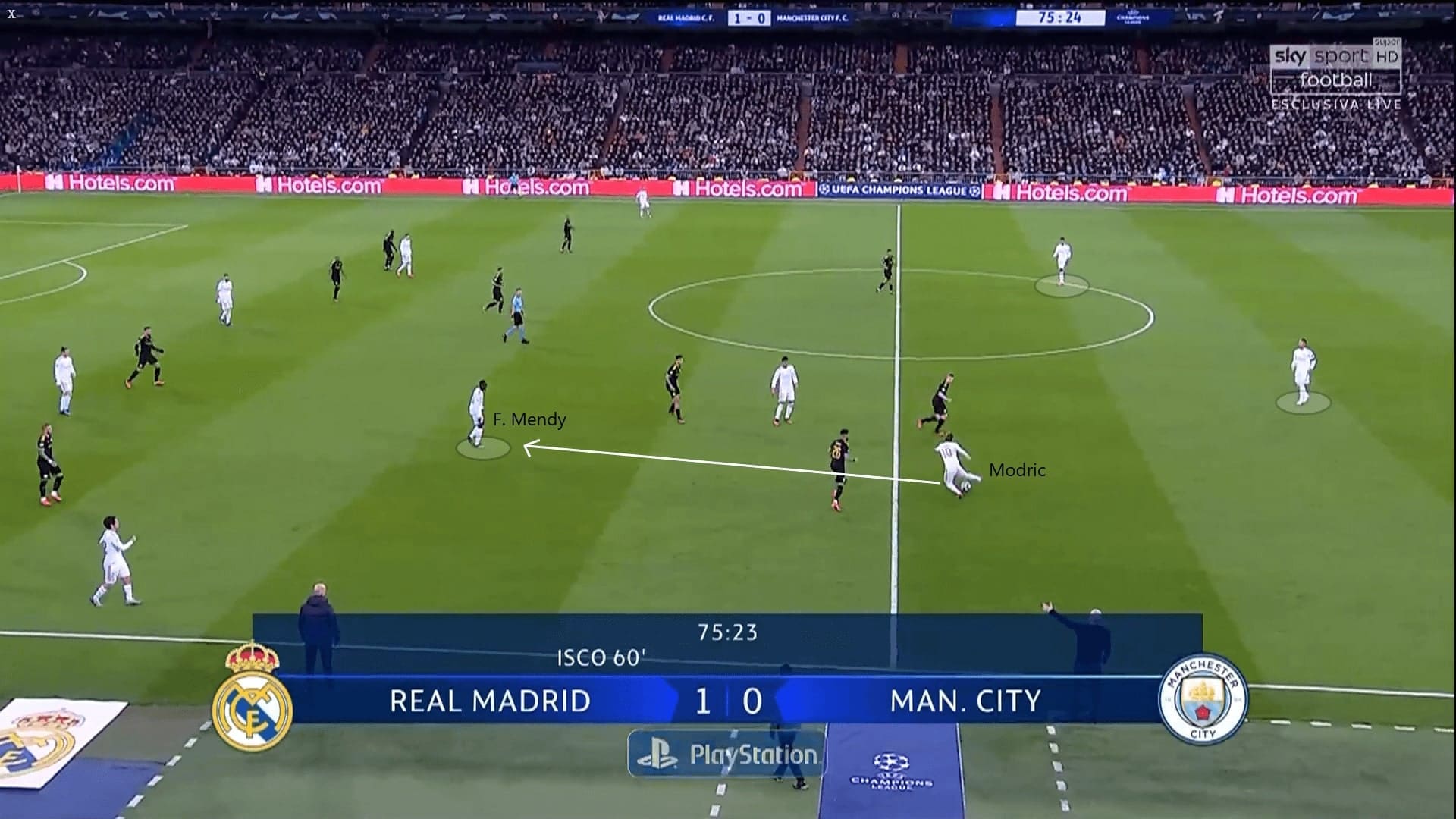
In other cases, the out balls were usually long passes, which was not the best in terms of the effects and qualities. This is the long-ranged passing map of Madrid, from the top passing links, we could see the receivers were usually the full-backs or Vinícius.
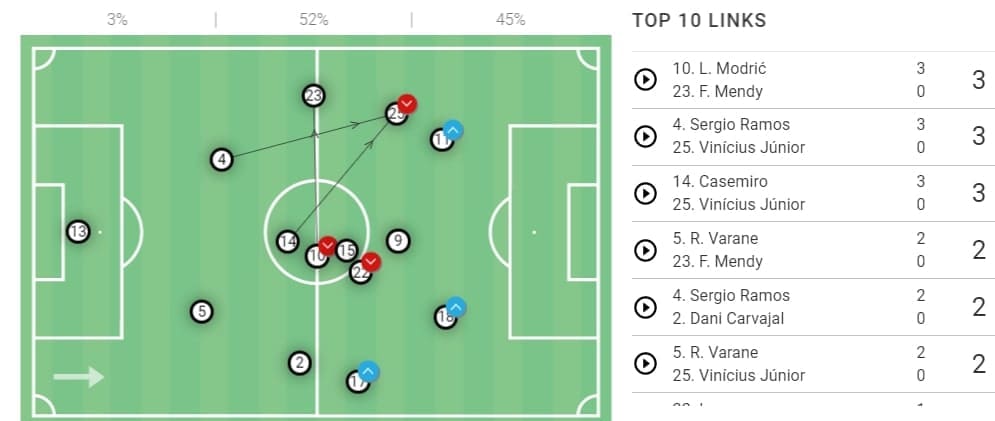
Below is the heat map of Vinícius. The young Brazilian was an attacking focus in this game. As we analyzed in our tactical previews, spaces behind City full-backs were the key zone to attack. Apparently, Zidane and his team tried to do that with the pacey and skilful No.25. Vinícius stayed very wide in this game, even reaching the touchline. He was trying to lure Walker out and take him on, but this was not totally successful as we are going to explain later.
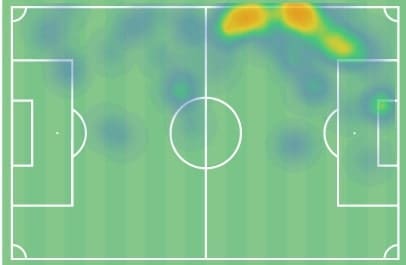
In this image, we show you the attacking shape of Madrid in the final third. As mentioned, Isco liked to roam from his position, so it was little wonder to see him appearing on the left. Vinícius jointed Benzema at the centre and attacked the box, keeping the City defenders narrow.
The positioning of Madrid’s front players opened the wide channel for F. Mendy, as shown in this image. The left-back recorded promising attacking stats in this game. He had an xA of 0.14, also completed three crosses out of five. Los Blancos had 36 attacks in this game, and half of them, which were 18 came from F. Mendy’s left flank. These included 0.58 xG of their total of 0.88.
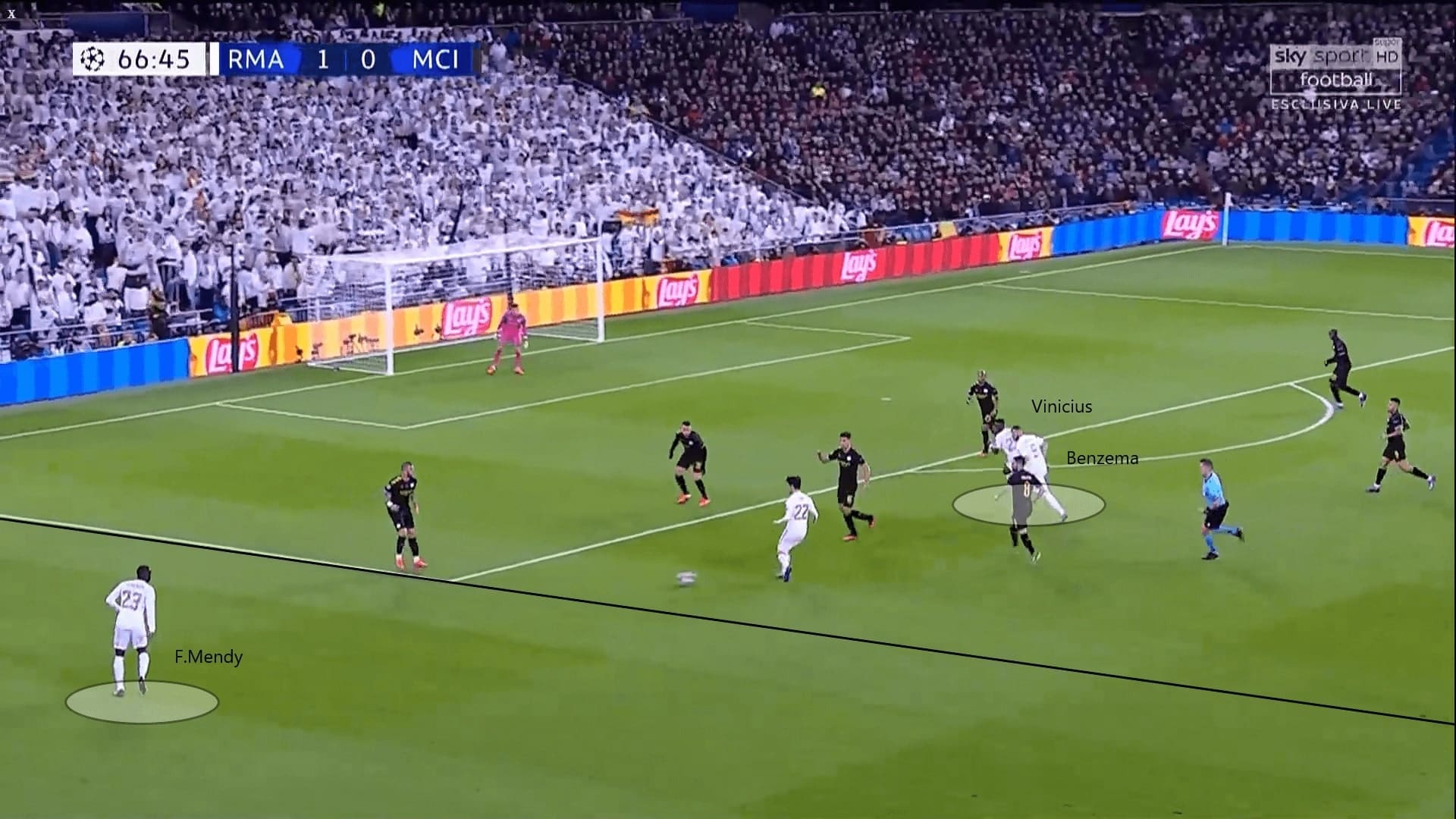
City’s clever defence
Despite not starting smoothly, City found their rhythm as the game went on. Their PPDA rose to 6.6 and maintained around 10.0 after the first 15 minutes. Guardiola’s men were well prepared to press Madrid and they did that wisely.
The pressing shape of City was a 4-4-2 in general, involving the midfielders and strikers. The formidable part of the press was to defend under an outnumbered circumstance. As mentioned, Madrid had the numerical advantage in the build-up. In terms of players, City could man-mark the full-backs (Mahrez -F. Mendy; Jesus – Carvajal), and they also had Rodri and Gündoğan to protect the central areas.
For De Bruyne and B. Silva, they formed the first line of defence. However, their jobs required football intelligence and correct judgement. They were not pressing the defenders simultaneously and instantaneously. Instead, they allowed Varane or Ramos to get on the ball and carry it forward until the passing lanes between the centre-backs were shut. This was the moment that triggered City’s press.
As you can see in this image, B. Silva was approaching Varane. De Bruyne was covering both Casemiro and Ramos as he positioned between both players. As the Frenchman carried the ball forward, he narrowed the angle to switch the ball to his partner. In other words, he was forced to pass laterally or forward in order to prevent from an awkward pass. Carvajal received the ball and quickly returned in this case.
Although City did not win the ball high, they denied quality progress of Madrid’s attacks. When considering the ball-playing abilities of the opposition, if the Citizens let a Madrid player progress the attack, that would be Casemiro ideally. The Brazilian was not the best passer, and his pass completion rate was the lowest among the starting Madrid players. He completed 48 passes out of 59 (81%).
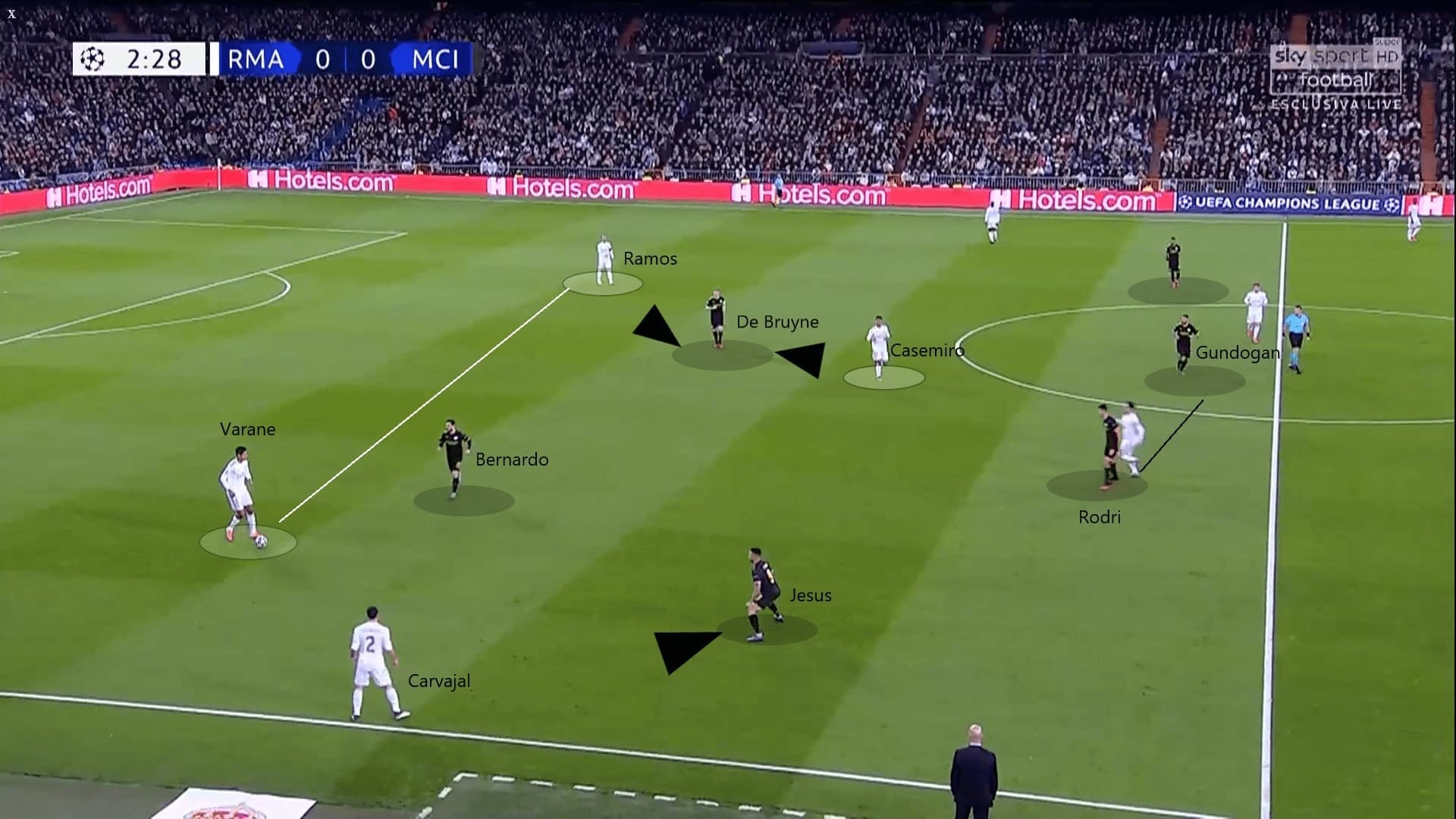
Below was another example. City tried to force Madrid to build-up through Carvajal and Varane as they were less threatening than the combination of Ramos and F. Mendy. And, when Jesus left Carvajal to approach the central players, it fell to B. Mendy to step up and control the Spaniard.
It was a shame that Madrid lacked a pacey winger. Isco did not offer pace to exploit spaces behind B.Mendy. In this case, as Jesus approached Modrić, B. Mendy had to step forward to reduce his distance with Carvajal.
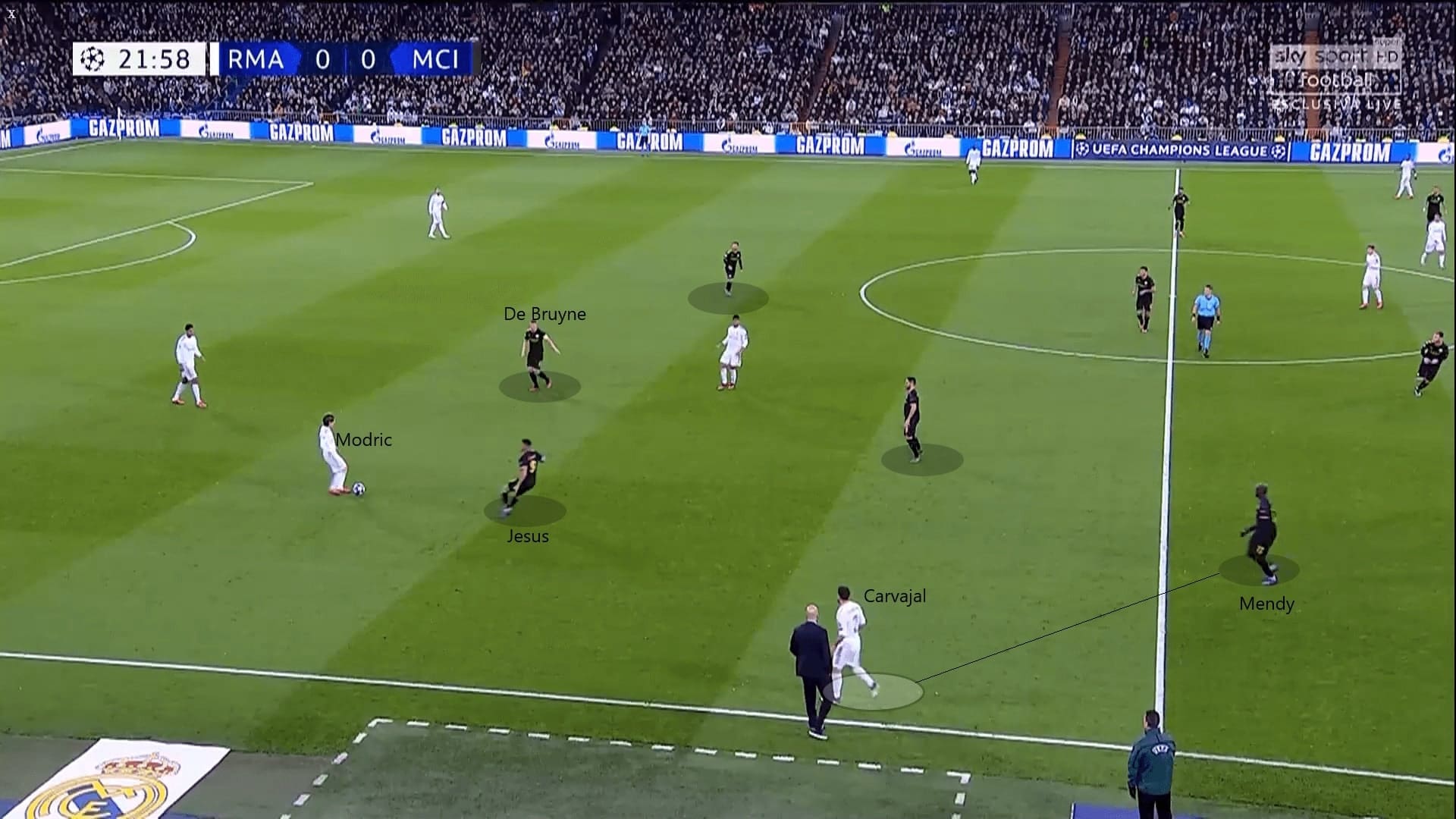
When defending on the other side, the job of Kyle Walker was slightly different from the left-back as the corresponding wingers were different. The right-back had to step out early to press Vinícius, to prevent the Brazilian from controlling the ball and using his skill to beat the defenders.
Therefore, you can see Walker always stayed behind the Brazilian in this game. There were two points to note in this image. First, Walker chose his positioning well as he maintained an appropriate distance with the target. If he sprinted close, he might be dribbled past due to his inability to turn in full speed. Second, Vinícius is a promising player, but in these cases, he lacks experience. He focuses too much on the ball with closed body orientation, and as a result, he was uncertain of the situation behind him. Thus, he just randomly kicked the ball behind.
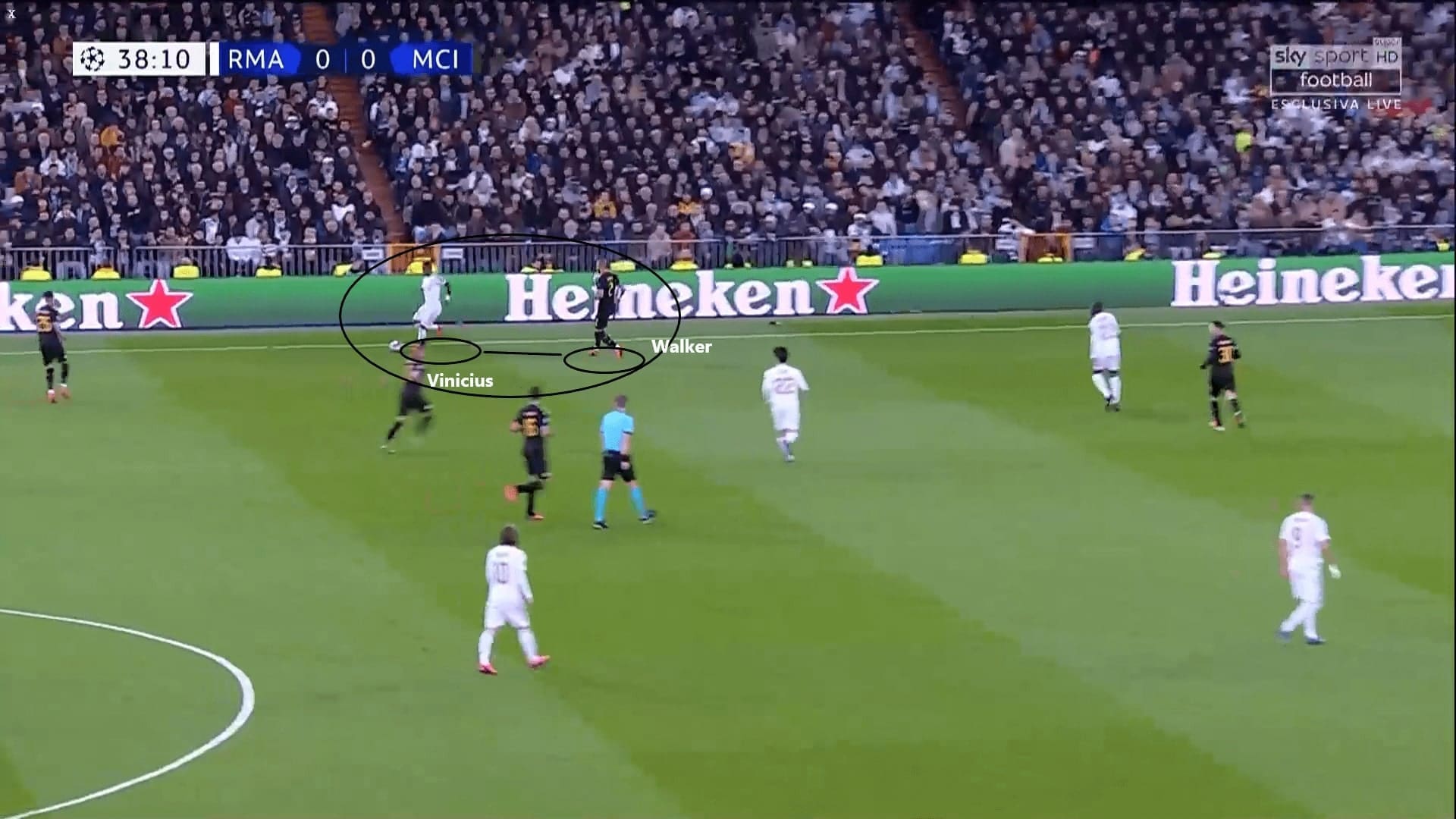
When defending deep, City tried to keep a compact low block. The main idea was to place their defenders to defend the cross. If the Madrid full-backs had to be approached, then, ideally this fell to the City wingers. Therefore, you can see in this image, the City back four were close to each other. Despite F. Mendy enjoying the width in the final third, Walker did not approach the former Lyon player. It was Mahrez’s job to cover the wide areas for Walker in this case.
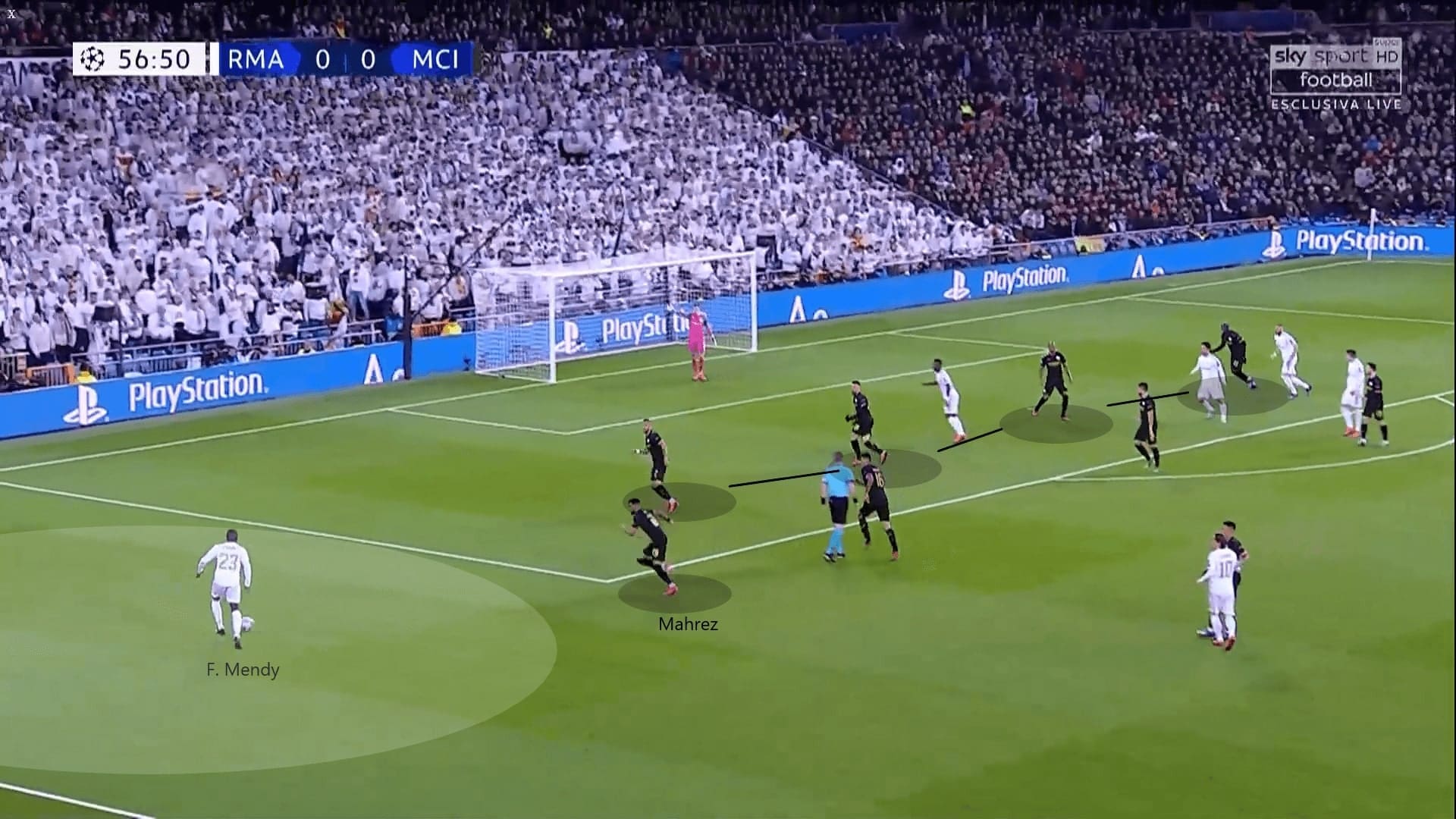
Why did Jesus start?
To further elaborate on the defence of City, we have to mention Jesus as he was a key part of the plan. He started ahead of Sergio Agüero, but he was playing on the left. We believe it was the relentless off-the-ball work of the Brazilian that won him the opportunity to start in this huge clash.
Below is the heat map of Jesus. We want to focus on his contributions in City’s defensive third. Apart from the opposition box, the Brazilian appeared the most frequently in this area. As mentioned, this was because of his tremendous defensive efforts.
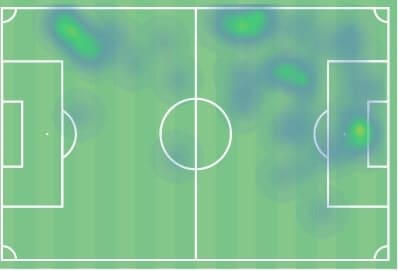
For more references, we show you the interception graph and recovery graph of Jesus in this game. In this game, the Brazilian had five interceptions and four recoveries. You may not be impressed by these figures. However, if we looked at where he won the ball, his presence was phenomenal to the team. We can see his defensive efforts ranged from the wide areas to the central third, as he covered the flank for B. Mendy.

We are going to show you an example of Jesus’ unquantifiable contribution. As mentioned, Madrid liked to use their full-backs to provide the width. Therefore, City had to limit Carvajal’s attacking threat. Guardiola did not want to see B. Mendy leaving the defenders and being isolated. Therefore, it was Jesus’ responsibility to defend the right-back.
You can see the positioning of Jesus in this image. He aligned with the defenders as an extra man to cover the wide areas, just like a left wing-back. Madrid could not find Carvajal with a long pass as Jesus would immediately react and approach him.
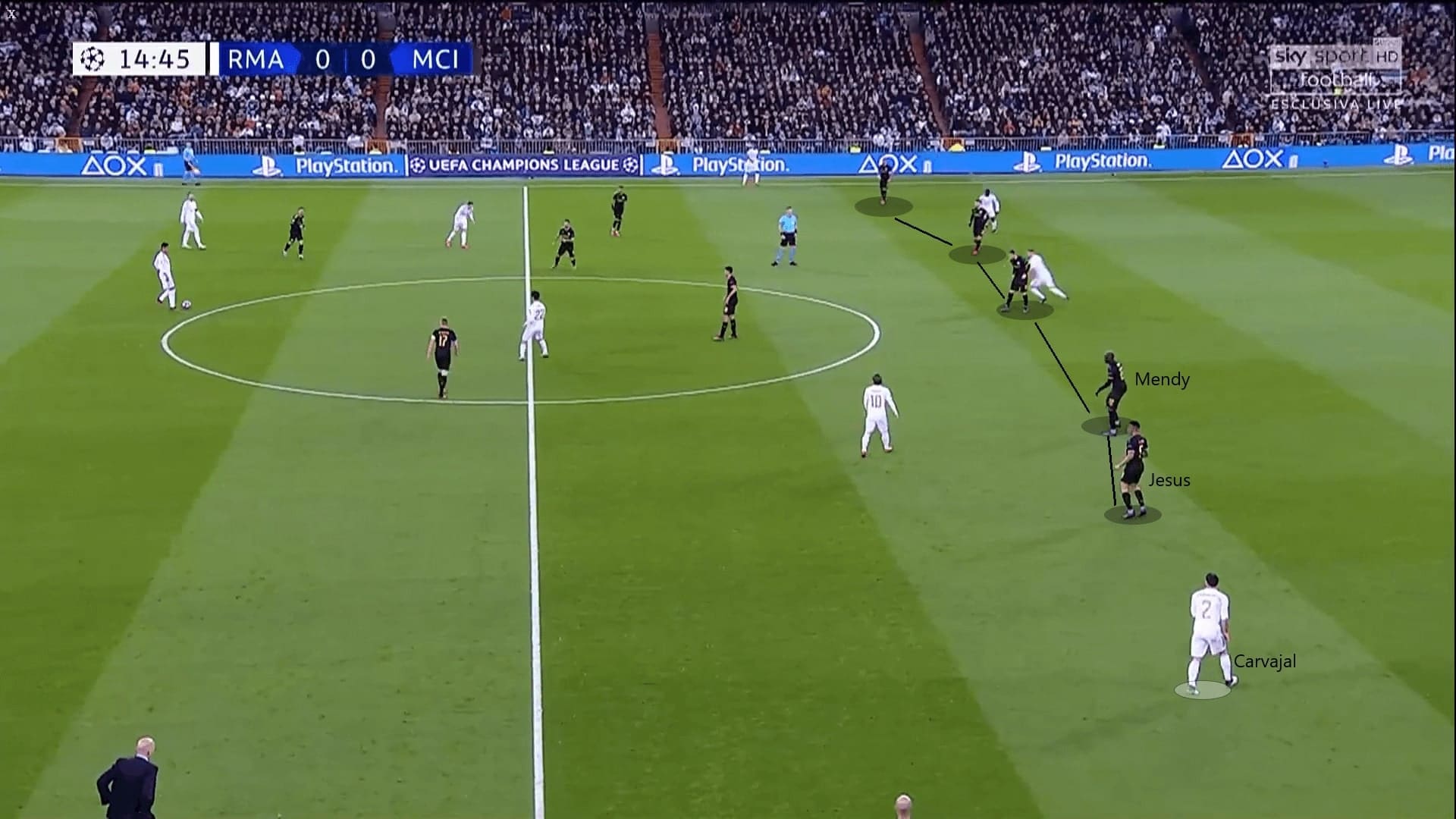
Positioning of City pivots provided solidity
Another part of City’s defensive structure was related to the offensive approach. Again, Guardiola played Gündoğan as Rodri’s partner as the latter was not fully fit for the role of a sole pivot. Therefore, the presence of the German was to shield the midfield as an extra man, so they had two in front of the centre-backs.
Below is the passing map of City. We want to show you the positioning of Rodri and Gündoğan. These two players stuck together tightly in the midfield, which helped them to cover each other and exchange passes. The close distance was beneficial to the defence, or counter-press situations, though the latter was not a common case in this game.
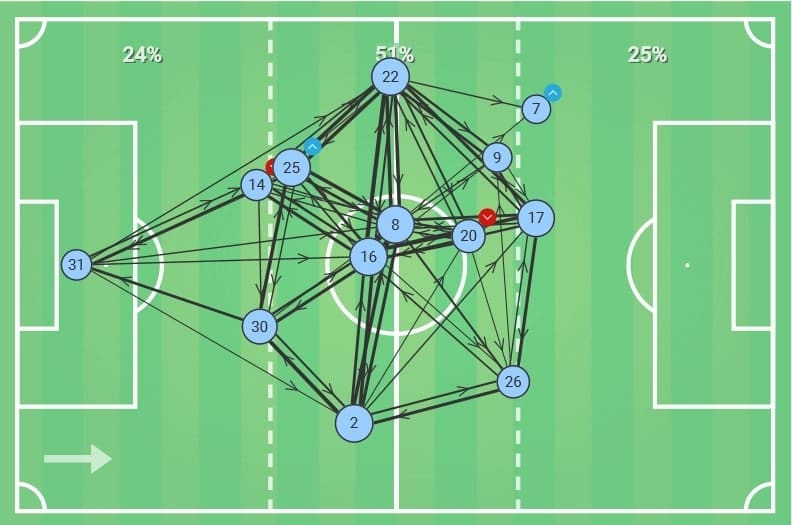
Below is an example. Rodri was slightly prone to commit an error or misjudging a pass. In this scene, his casual pass was intercepted, and the Los Blancos looked to start a counter. It was a dangerous situation if Rodri was the sole pivot as Karim Benzema was behind him. Fortunately, he had Gündoğan’s back up in this case, and the German controlled the ball to stop a transition.
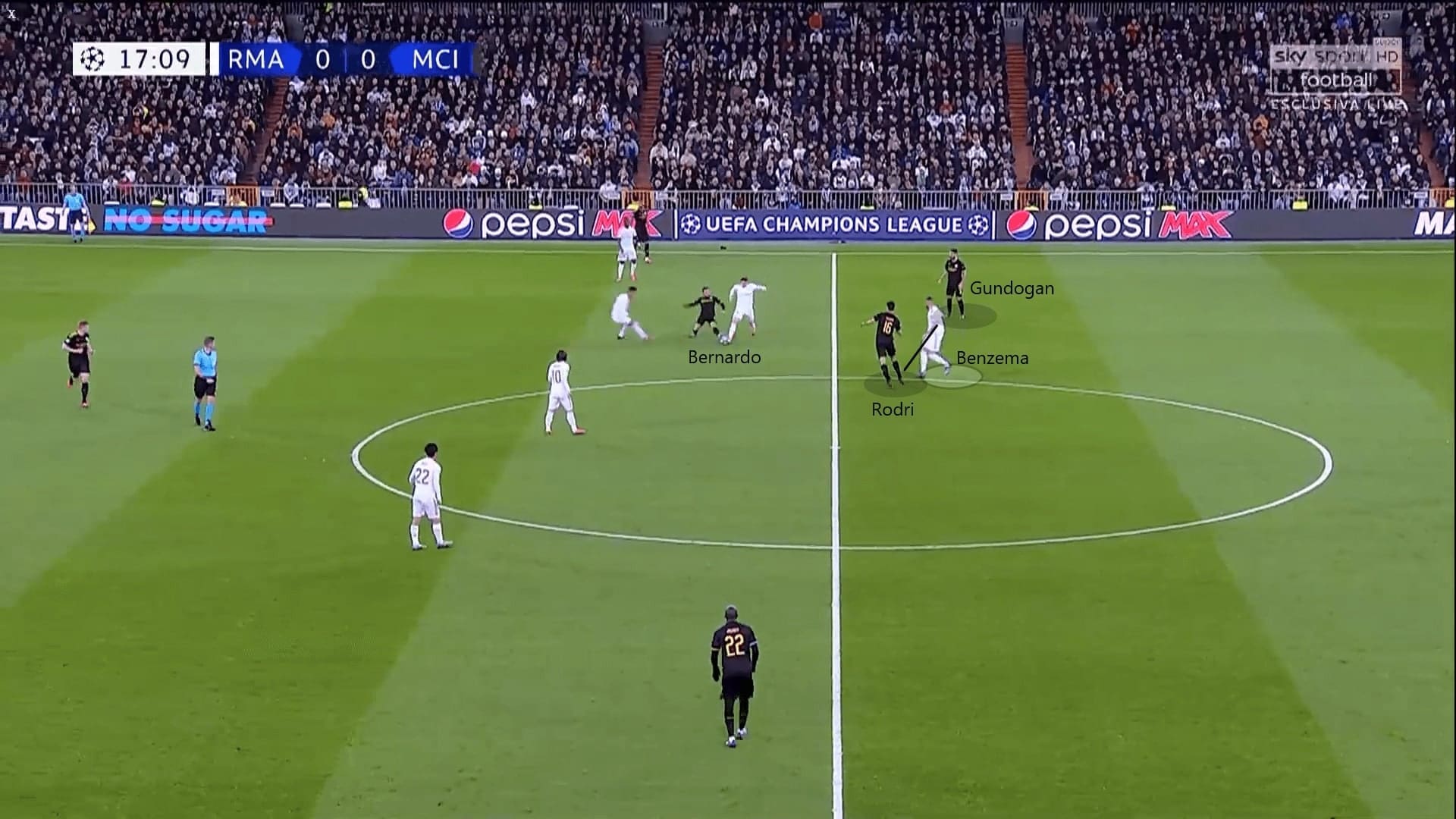
Zidane adjusted the defence
When defending, Madrid’s press was slightly different from previous patterns. In this match, they wanted to dominate the midfield and keep the defensive shape. Therefore, they focused on setting the block at the centre of the pitch. The roles of the players were flexible as they had the freedom to roam from their positions. For example, sometimes it was Modrić to defend from the front, while as the game went on, Valverde remained as the energetic pressing player upfront.
As you can see in the following mage, the double-pivot of City, Rodri and Gündoğan, were caged at the centre. It was risky for City to build-up through the centre, and this led to Madrid’s goal through Isco. Since a winger stayed narrow to add a number at the centre, they let one City full-back stay unmarked.
As mentioned in our tactical previews, Madrid’s full-backs can be easily manipulated by the positions of their opposite wide players. Zidane tried to prevent this situation from happening so B. Mendy and Carvajal stayed deeper when setting a block. As a result, you can see in this image, Madrid even committed a centre-back (Varane) and Casemiro to form the block. With this compact block at the centre, City could hardly play out from the back through the pivots.
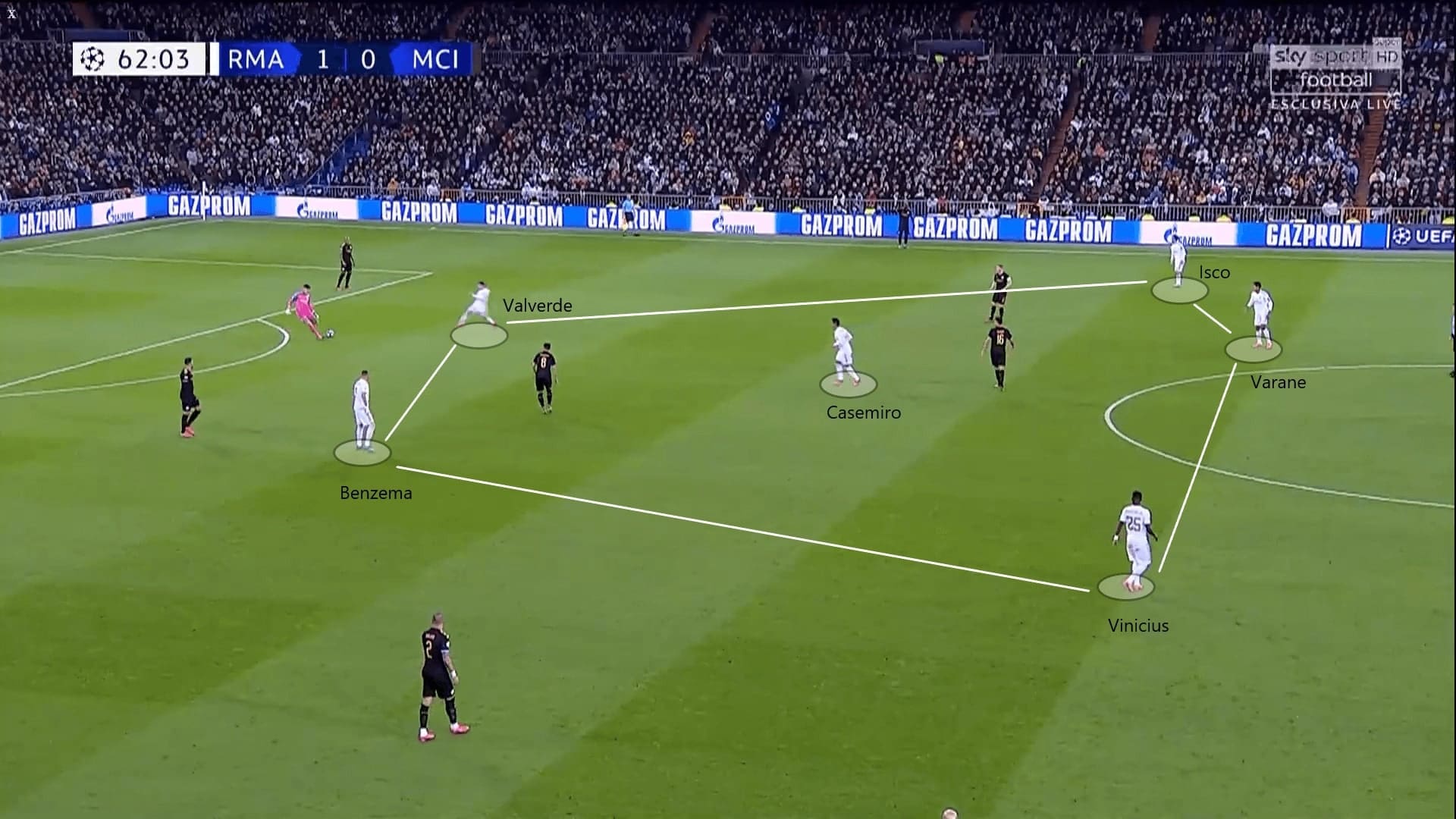
Ederson’s long passes did not work
Of course, Guardiola’s team was well-prepared to deal with the press as mentioned above. Only 9.50% of Madrid’s recoveries occurred in City’s defensive third. From the Barcelona game, we can see how Marc-André ter Stegen’s long passes broke Madrid’s press. Ederson was tasked to do something similar but the results were not the best.
The below graph is the long passes distribution of Ederson. The Brazilian completed eight out of 17 long passes for City. Apart from the delivery to the flanks as they capitalized on the pressing loopholes of Madrid, a prominent receiver in the opposition half was Mahrez. It was an intriguing set up as the Algerian was not a target man.
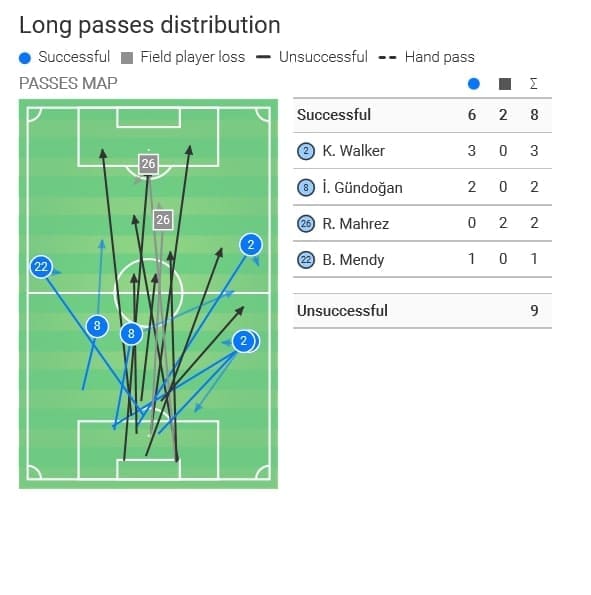
The below image showed the general structure of City’s build-up. Guardiola’s men placed the double-pivot at the centre and moved the full-backs wide in this phase. For De Bruyne and B. Silva, they stayed behind the midfield line of Madrid to search for spaces between the lines. With these setups, they separated Madrid’s defence into three to four layers. By leaving the wingers Mahrez and Jesus high, Ederson had the targets when he played long.
The idea of this positioning was to invite pressure. This left Jesus and Mahrez in a 2-v-2 situation against the centre-backs. Although the Algerian did not possess the physical superiority to serve as a target man, Guardiola still wished to utilize his exceptional first-touch and technique to control the ball.
In addition, the situations of Carvajal and F. Mendy were slightly awkward. They appeared in the half-spaces as Madrid tried to prevent an overload on Casemiro. However, when the ball bypassed them, it was difficult to track the late runs of De Bruyne and B. Silva.
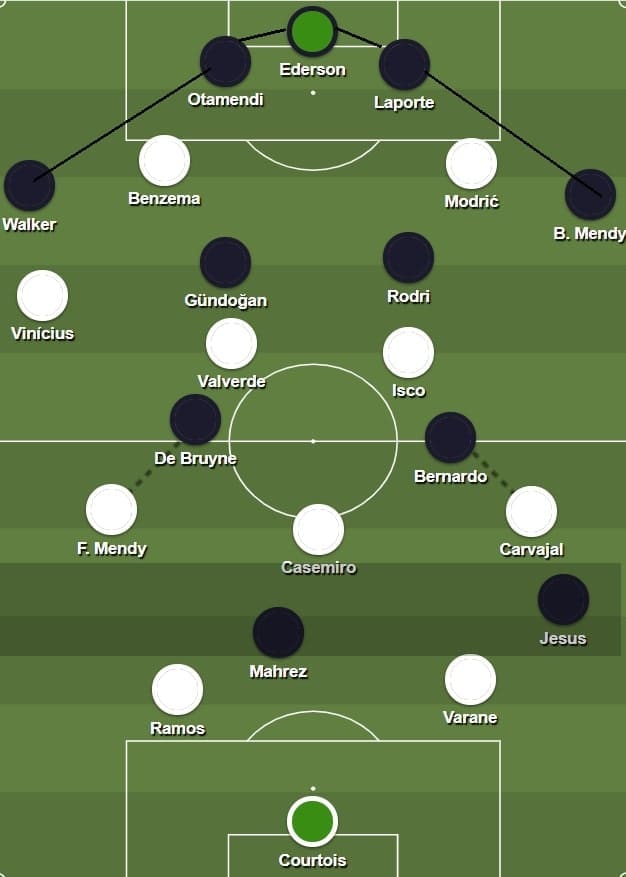
This was an example where Ederson’s long pass managed to reach the opposition’s final third. Mahrez positioned himself inwards early to drag the defenders with him, hence, Jesus became the free player on the left. Both Varane and Ramos were forced to retreat and created huge spaces which gave De Bruyne and B. Silva room to exploit with their forward runs. This approach was not fully successful as the control of Jesus and Mahrez, and the deliveries of Ederson were not the best in this game. The quality of the passes and control on the ball could be further enhanced.
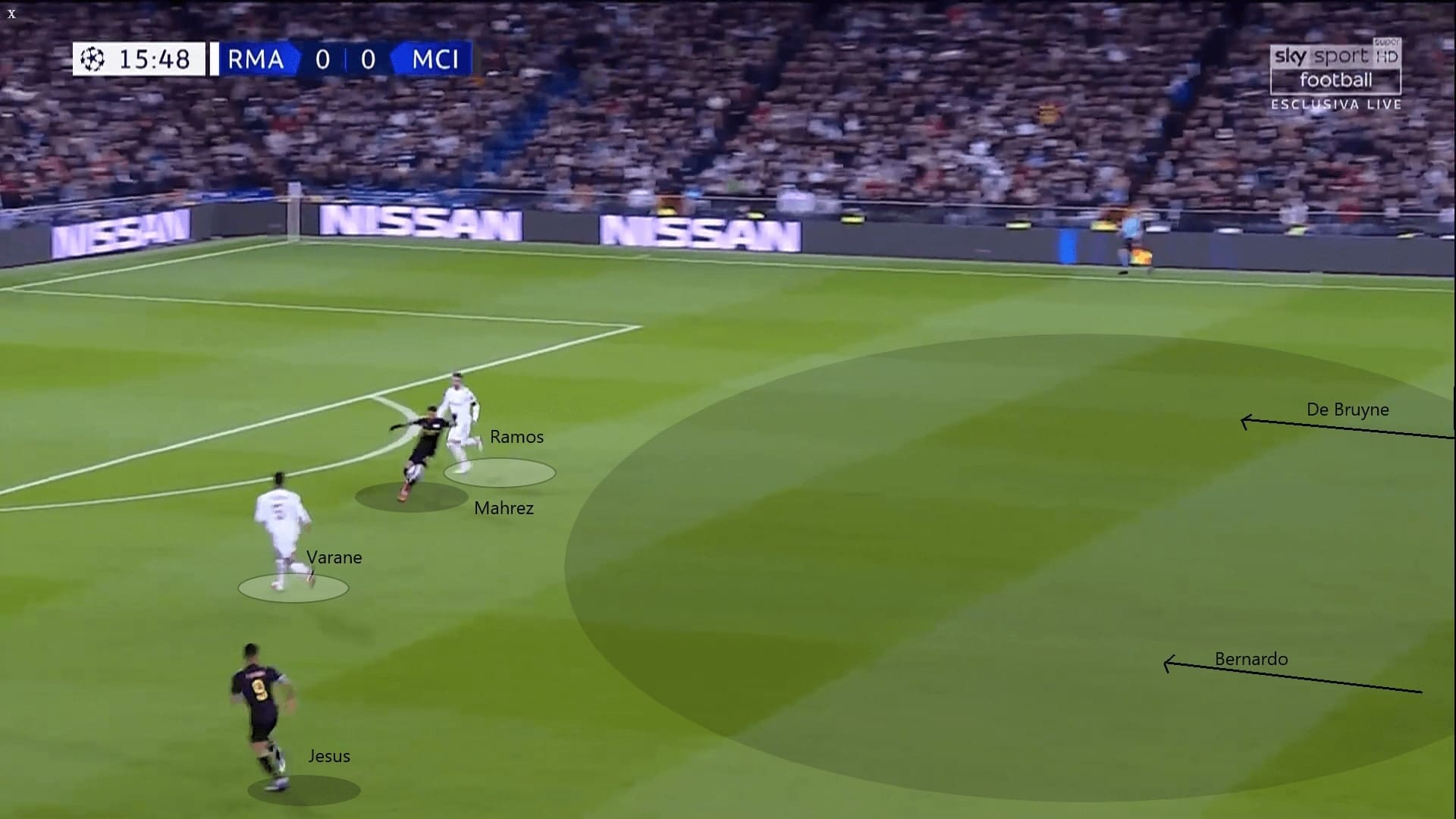
City’s fluid attacks
Given the familiarity of players, in the attacks, City players were fluid in switching their positions and roaming across the pitch. In order to set De Bruyne free, Guardiola invited the press of Madrid with the build-up. If the Citizens broke the press and further progressed up the pitch, De Bruyne appeared in space between the lines.
This was an example where De Bruyne created a chance for Jesus in the first half (0.38 xG). Casemiro was switched off as he did not approach the Belgian immediately. As mentioned in our tactical previews, the horizontal gaps between the Madrid defenders was the loophole. De Bruyne managed to penetrate between Varane and Carvajal to reach Jesus in the box.
Playing as a left-winger, Jesus stayed inside early on. The Brazilian also possessed the pace to beat Carvajal. When he left the wide areas, City had B. Mendy to push forward and occupy those areas in the attack.
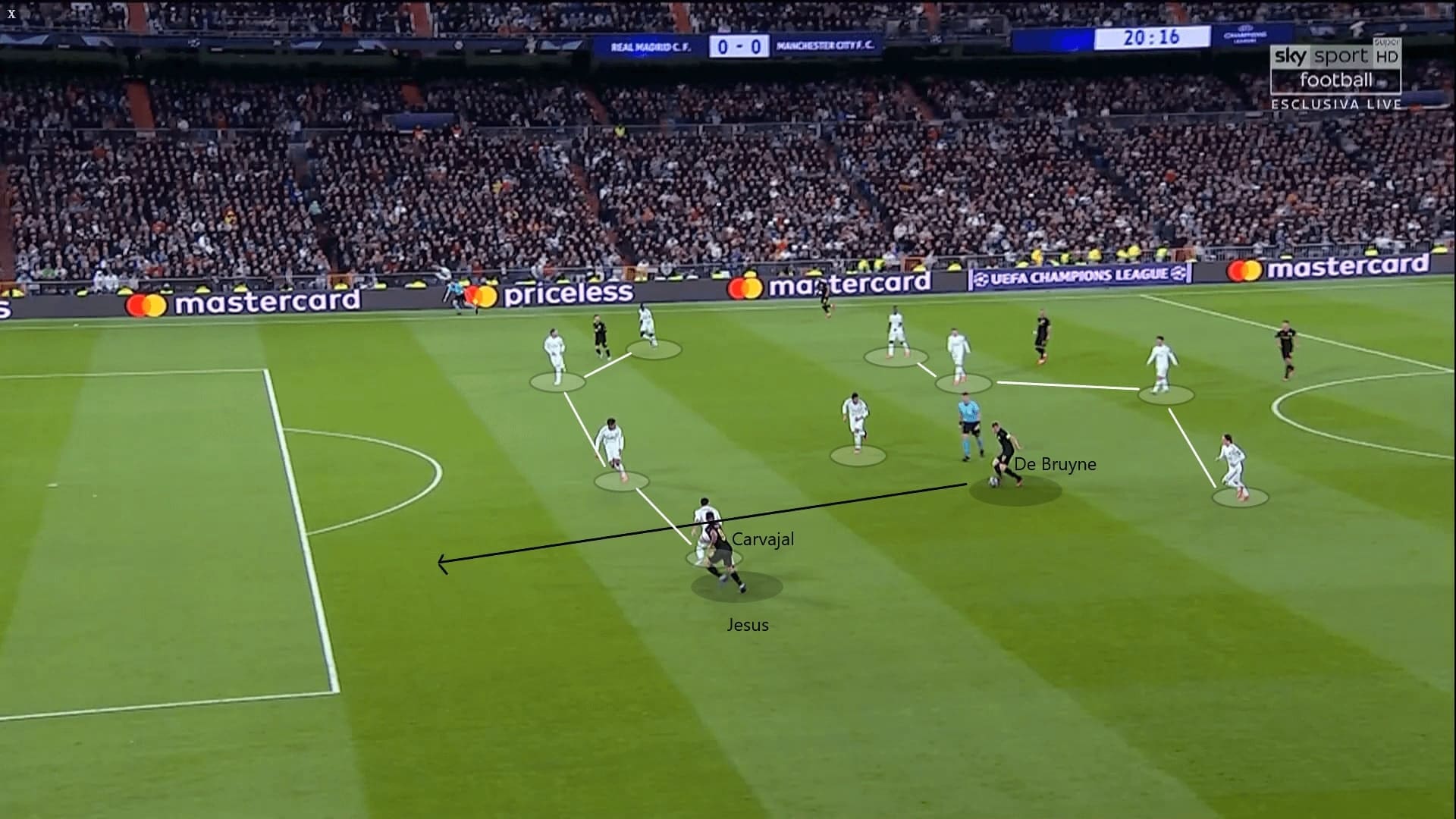
In the offensive transitions, City were also promising. The defence on City’s right flank was slightly looser than the left, especially when it came to marking the full-backs. A possible explanation was that Mahrez tried to control F. Mendy by his positioning. He stayed behind the Frenchman and utilized the space behind him in the offensive transitions. You can see in this case, when De Bruyne was carrying the ball forward, Mahrez was free to join as F. Mendy stayed too high.
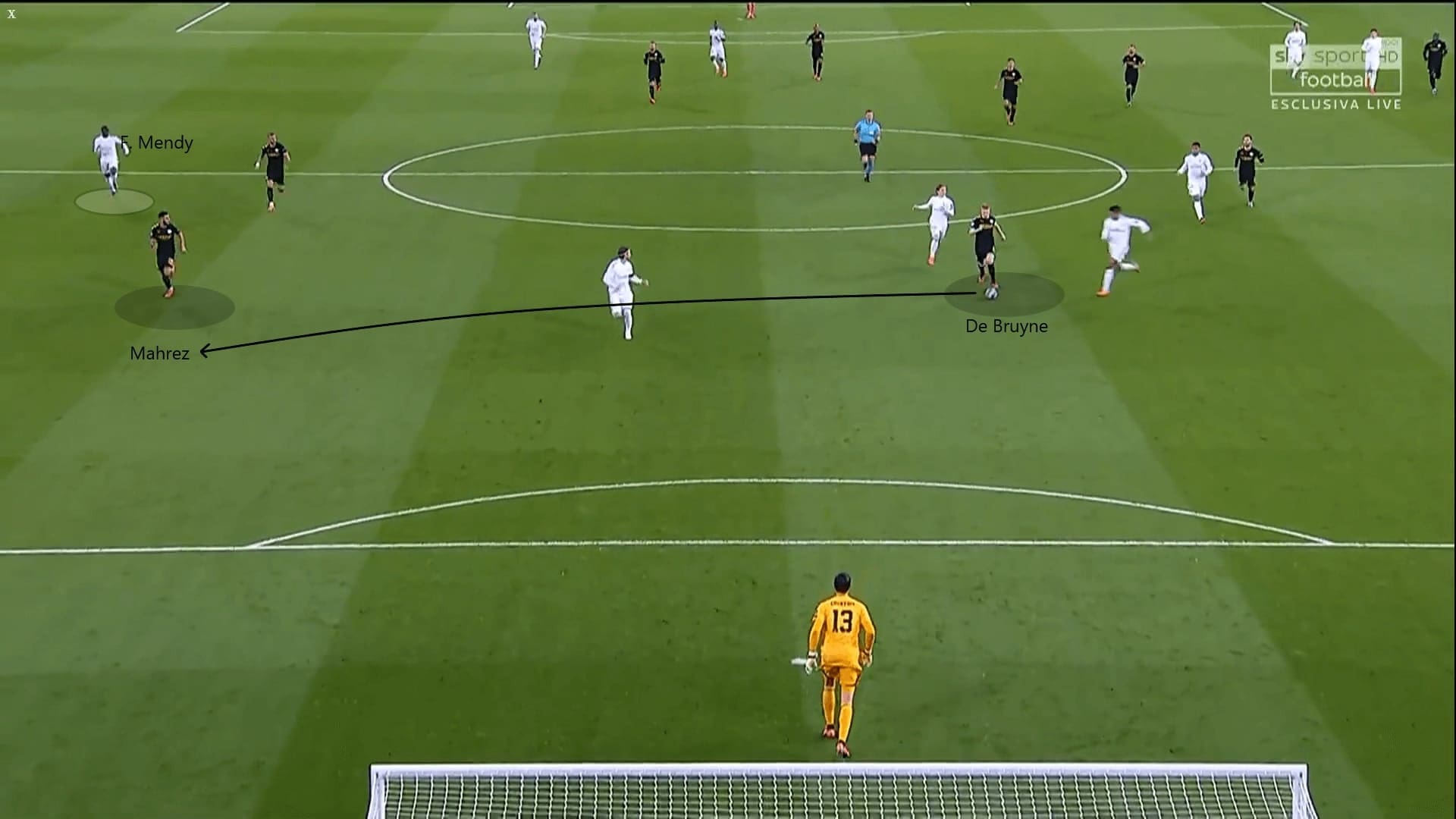
Guardiola’s excellent response
As former Arsenal manager Arsène Wenger said, the introduction of Raheem Sterling made an instant impact and won City the game. Jesus now played as the centre-forward as Sterling was the left-winger. Statistically, the Englishman completed all nine passes (100%); won a penalty; completed five of his eight offensive duels (63%); dribbled four times and succeeded twice; and recovered the ball twice in the opposition’s half.
A more important impact was that this eased the burden on De Bruyne. With Sterling, City had another focal point to their attack. Since Madrid were aware of the pace and skills of the 25-year-old, they committed huge numbers to approach him, and this gave De Bruyne the chance to get rid of his markers.
In this example, we demonstrate this situation. Sterling’s presence took seven Madrid players on the ball side, despite there being only two City players. De Bruyne was free as he was positioned outside of the block. When everyone paid attention to Sterling, he was free to receive the pass from Gündoğan.
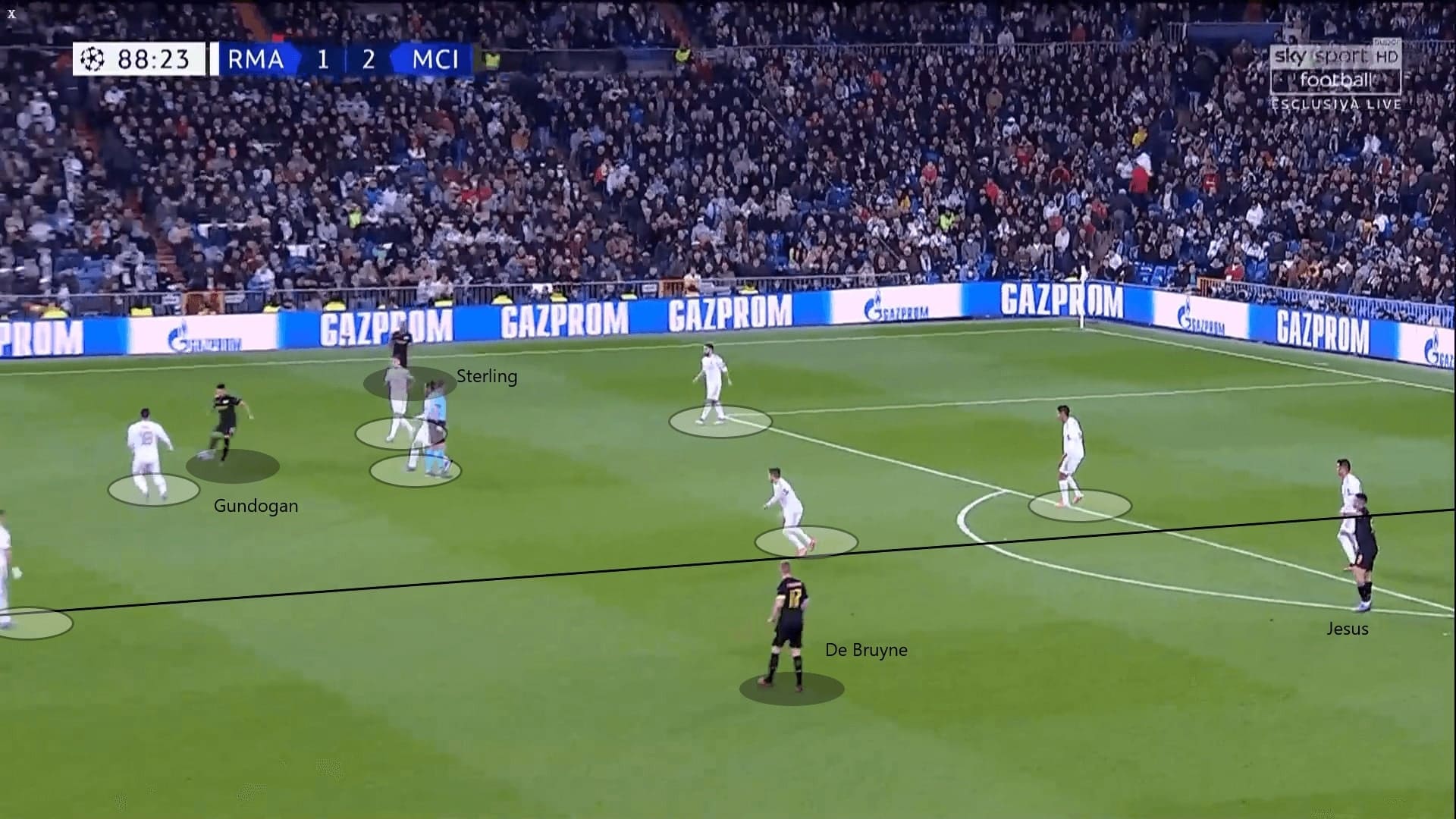
For Jesus, he was more natural at the centre-forward position and it was his good movement which led to the equalizer. In this goal, the contribution of Sterling and De Bruyne caught the eyeballs. However, the positioning of Jesus was equally vital.
When De Bruyne received the pass from Sterling initially, Jesus kept his distance to Ramos and stayed around the penalty spot. This gave the Brazilian a good shape to attack both the front post and far post.
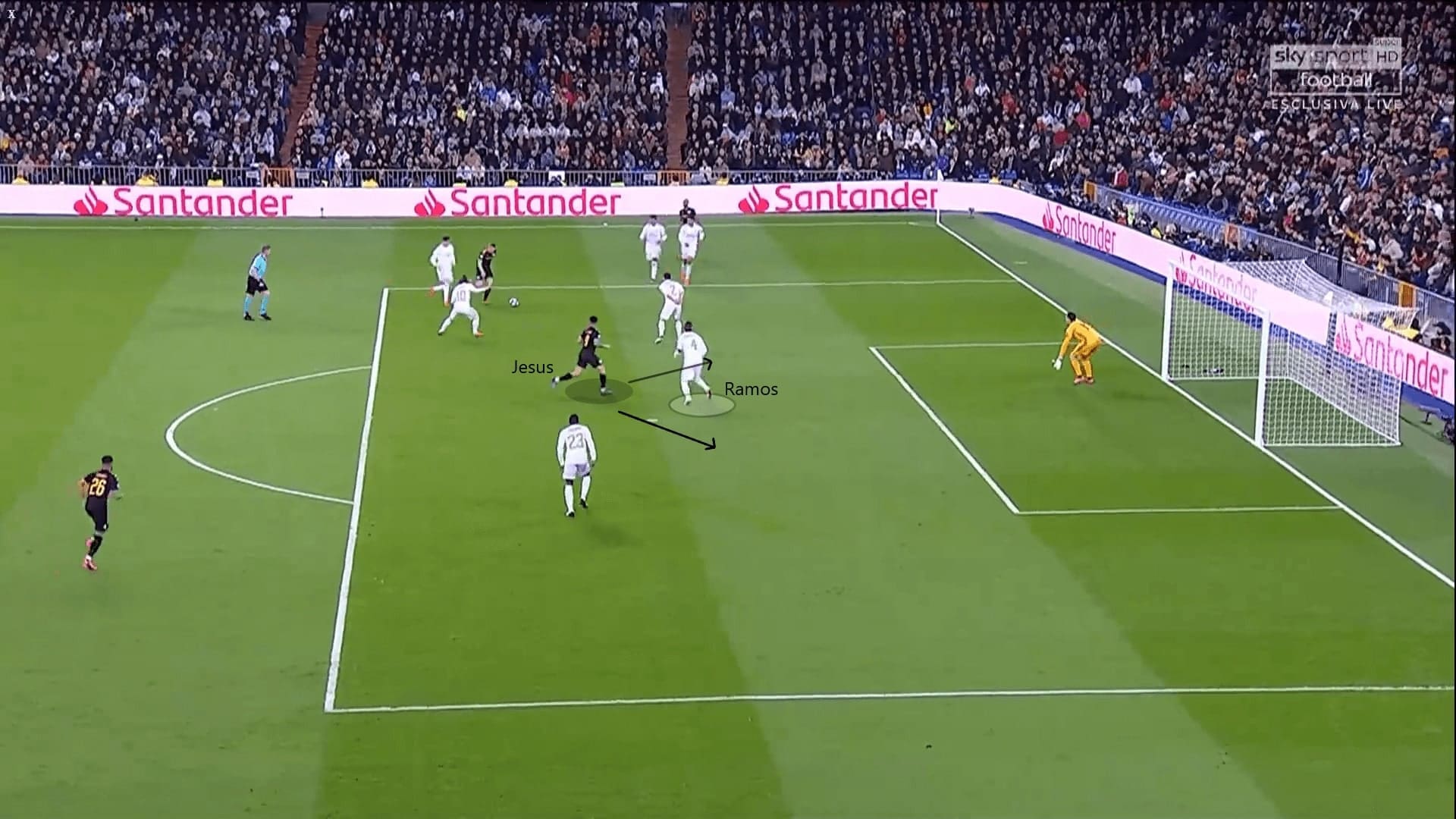
As De Bruyne did not cross early, the attack continued. Jesus was patient and clever to stay on Ramos’ blindside. De Bruyne attracted the opposition and Ramos also had to focus on the ball, so he did not check Jesus’ positioning. The Brazilian waited until the last moment to decide the direction of his run, as it depended on the delivery. In this case, De Bruyne’s pass was made to the far post, so Jesus ran behind Ramos and scored.
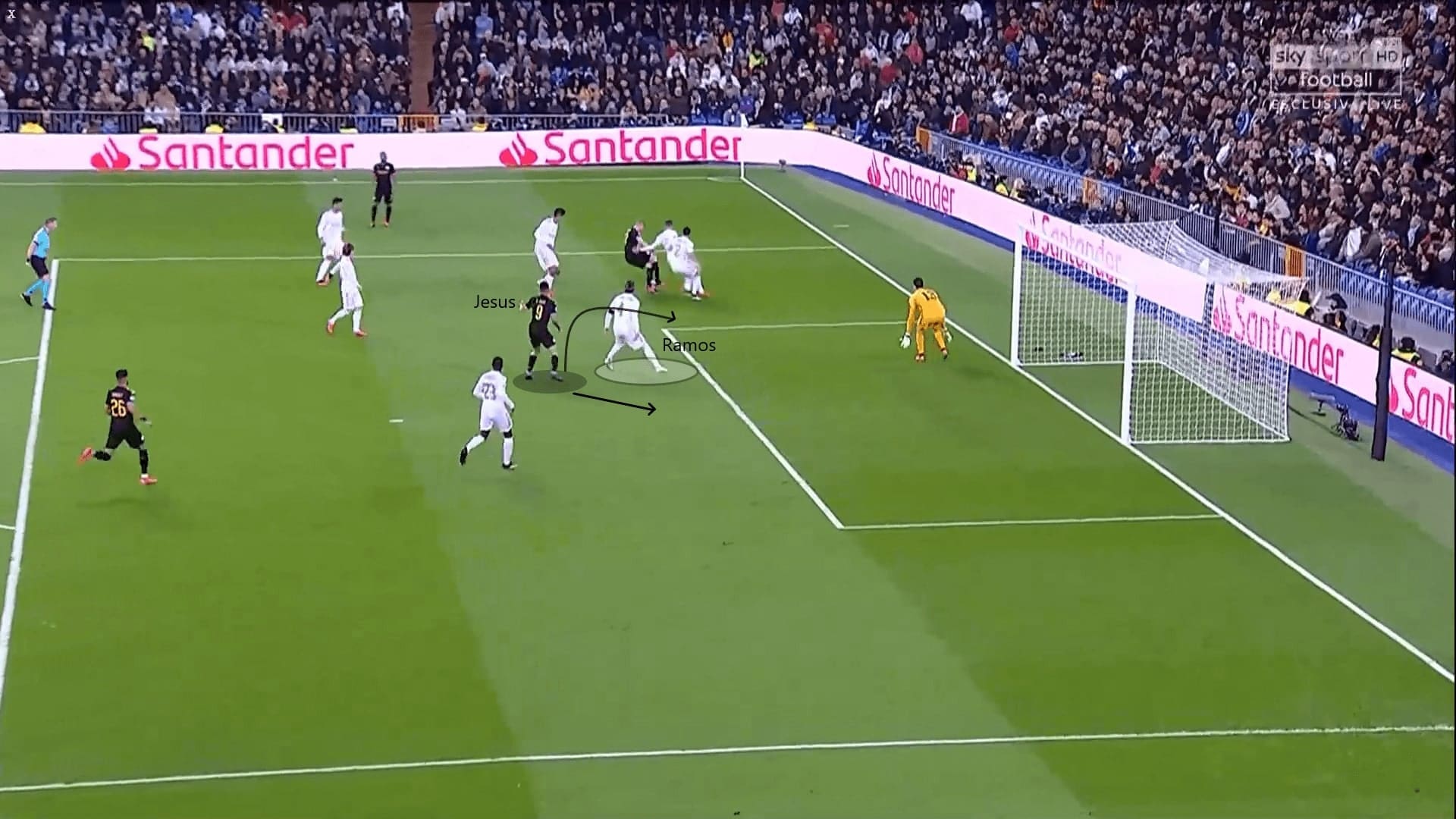
Conclusion
This must be one of the greatest victories in City’s history which every City fan would have imprinted on their minds. These tactics were different from the usual approach of City, but they were not new. We have seen similar pressing systems and uses of the double-pivot in their 3-1 win at Old Trafford. Mentally, City were better than before as they did not give up when they were a goal down, and the spirit of the team also contributed to this victory.
For Madrid, it was not their best game, especially when we look at the xG difference (0.88 – 3.05). Offensively, they did not have many options with Benzema not in good form, and they lacked an experienced pacey winger to create a threat down the flanks. Somehow, their attacks were over-reliant on F. Mendy in the final third, and this is not a good sign. They have to find ways to construct a more stable and effective attacking approach. Defensively, the quality of their individuals did not save the Los Blancos this time, and they were lucky to concede two goals only from a statistic point of view. The tie is not totally lost, though, and we shall see what is going to happen at the Etihad in a few weeks’ time.





Comments